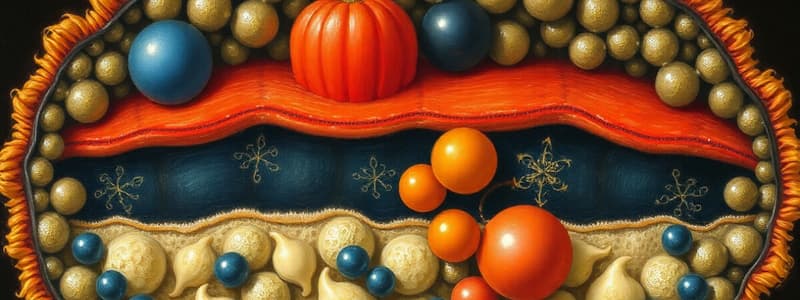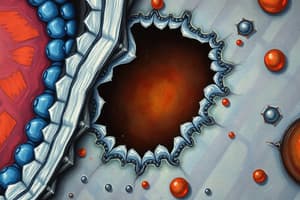Podcast
Questions and Answers
What is a primary consequence of the malfunctioning CFTR protein in cystic fibrosis?
What is a primary consequence of the malfunctioning CFTR protein in cystic fibrosis?
- Increased transport of sodium ions out of cells
- Retention of chloride ions within the cells
- Decreased production of bile in the liver
- Thickening of the mucus lining in the lungs (correct)
Why is the hydration of the lungs and intestinal tract essential?
Why is the hydration of the lungs and intestinal tract essential?
- It promotes vasodilation and increased blood flow.
- It allows for effective gas exchange in the lungs. (correct)
- It improves the storage of bile within the liver.
- It facilitates the absorption of carbohydrates in the intestines.
What role does the CFTR protein play in normal cellular function?
What role does the CFTR protein play in normal cellular function?
- Functions as a structural component of the plasma membrane
- Facilitates the uptake of glucose into cells
- Regulates the production of digestive enzymes
- Transports chloride ions out of cells (correct)
What is one of the major health risks for cystic fibrosis patients related to mucus build-up?
What is one of the major health risks for cystic fibrosis patients related to mucus build-up?
How does the malfunction of CFTR affect sodium ion movement?
How does the malfunction of CFTR affect sodium ion movement?
What is the result of water retention within cells due to CFTR malfunction?
What is the result of water retention within cells due to CFTR malfunction?
What dietary adjustment do cystic fibrosis patients often require?
What dietary adjustment do cystic fibrosis patients often require?
What type of mutation causes cystic fibrosis?
What type of mutation causes cystic fibrosis?
What is a primary characteristic of transmembrane proteins?
What is a primary characteristic of transmembrane proteins?
What distinguishes gated channel proteins from ungated (leak) channels?
What distinguishes gated channel proteins from ungated (leak) channels?
Which statement accurately describes peripheral membrane proteins?
Which statement accurately describes peripheral membrane proteins?
What is the function of glycoproteins in the extracellular matrix (ECM)?
What is the function of glycoproteins in the extracellular matrix (ECM)?
Which type of protein acts like a turnstile or revolving door in the membrane?
Which type of protein acts like a turnstile or revolving door in the membrane?
What is one of the main functions of the extracellular matrix (ECM)?
What is one of the main functions of the extracellular matrix (ECM)?
Where are extracellular peripheral proteins primarily located?
Where are extracellular peripheral proteins primarily located?
What is a key role of intracellular peripheral proteins?
What is a key role of intracellular peripheral proteins?
What is the primary feature of the fluid mosaic model regarding the movement of molecules in the membrane?
What is the primary feature of the fluid mosaic model regarding the movement of molecules in the membrane?
Which type of fatty acid allows lipid molecules to pack more tightly together in the membrane?
Which type of fatty acid allows lipid molecules to pack more tightly together in the membrane?
What role does cholesterol play in the plasma membrane?
What role does cholesterol play in the plasma membrane?
What is the main characteristic of integral membrane proteins?
What is the main characteristic of integral membrane proteins?
Which of the following correctly describes amphipathic molecules?
Which of the following correctly describes amphipathic molecules?
Which function is NOT associated with membrane proteins?
Which function is NOT associated with membrane proteins?
What determines the dynamic nature of the lipid bilayer in membranes?
What determines the dynamic nature of the lipid bilayer in membranes?
Which category does NOT describe a function of membrane proteins?
Which category does NOT describe a function of membrane proteins?
What structural feature prevents hydrophobic tails of phospholipids from facing water?
What structural feature prevents hydrophobic tails of phospholipids from facing water?
What type of membrane protein is specifically bound to the inner or outer surface of the membrane?
What type of membrane protein is specifically bound to the inner or outer surface of the membrane?
Flashcards
Organelles
Organelles
Specialized structures within a cell that perform specific cellular processes. They are often surrounded by a membrane.
Plasma Membrane
Plasma Membrane
A flexible barrier that surrounds the cytosol of a cell. It controls what enters and exits the cell.
Membrane-bound organelles
Membrane-bound organelles
A system of membrane-bound organelles that allows cells to function properly.
Cystic Fibrosis (CF)
Cystic Fibrosis (CF)
Signup and view all the flashcards
CFTR (Cystic Fibrosis Transmembrane Conductance Regulator)
CFTR (Cystic Fibrosis Transmembrane Conductance Regulator)
Signup and view all the flashcards
Osmosis
Osmosis
Signup and view all the flashcards
Electrical Gradient
Electrical Gradient
Signup and view all the flashcards
Thick Mucus in CF
Thick Mucus in CF
Signup and view all the flashcards
Integral Protein
Integral Protein
Signup and view all the flashcards
Glycoprotein
Glycoprotein
Signup and view all the flashcards
Channel Protein
Channel Protein
Signup and view all the flashcards
Ungated (Leak) Channel
Ungated (Leak) Channel
Signup and view all the flashcards
Gated Channel
Gated Channel
Signup and view all the flashcards
Carrier Protein/Pump
Carrier Protein/Pump
Signup and view all the flashcards
Peripheral Membrane Protein
Peripheral Membrane Protein
Signup and view all the flashcards
Extracellular Peripheral Protein
Extracellular Peripheral Protein
Signup and view all the flashcards
Fluid Mosaic Model
Fluid Mosaic Model
Signup and view all the flashcards
Phospholipid
Phospholipid
Signup and view all the flashcards
Phospholipid Bilayer
Phospholipid Bilayer
Signup and view all the flashcards
Membrane Fluidity
Membrane Fluidity
Signup and view all the flashcards
Factors Affecting Membrane Fluidity
Factors Affecting Membrane Fluidity
Signup and view all the flashcards
Integral Membrane Proteins
Integral Membrane Proteins
Signup and view all the flashcards
Transport
Transport
Signup and view all the flashcards
Enzymatic Activity
Enzymatic Activity
Signup and view all the flashcards
Triggering Signals
Triggering Signals
Signup and view all the flashcards
Study Notes
Membrane Structure and Function
- Organs are specialized structures in the body that perform specific life processes.
- Organelles are specialized structures inside cells, often surrounded by membranes, that perform specific cell processes.
- The plasma membrane (cell membrane) is a dynamic barrier surrounding the cell's cytosol. All cells and organelles are enclosed by a flexible membrane.
- Membrane-bound organelles are critical for healthy life. Malfunction or damage can lead to disease.
- Cystic fibrosis (CF) is a disease caused by a single gene mutation affecting the CFTR protein.
- CFTR is a membrane transport protein that normally moves chloride ions (Cl⁻) out of cells lining the lungs/intestines, creating an electrical gradient. This gradient facilitates sodium ion (Na⁺) movement, drawing water into the mucus. This hydration is essential for proper lung and intestine function
- In CF, the Cl⁻ channel malfunctions, reducing hydration of the mucus, which becomes thick. This thick mucus blocks airways, making breathing difficult, clogs pancreatic ducts, and impairs enzyme delivery, leading to possible pancreatic damage and digestive enzyme deficiency. CF patients often require dietary supplements.
- The fluid mosaic model, proposed by Singer and Nicolson (1972), describes membranes as fluid and mosaic.
- Fluid implies dynamic movement of membrane components.
- Mosaic implies a diverse array of molecules within the membrane.
- The model suggests a membrane of fluid phospholipid bilayer in which proteins are embedded and can move laterally.
- Membranes are not rigid; proteins and lipid molecules are generally free to move laterally within the two layers of the bilayer.
Membrane Composition
- The plasma membrane is a mosaic of various molecules:
- Phospholipids
- Membrane proteins (integral and peripheral)
- Carbohydrates
- Cholesterol
Phospholipid Bilayer
- Membranes are primarily made of phospholipids. These lipids form a bilayer, two layers of phospholipids.
- Phospholipids have both hydrophobic (water-fearing) tails and hydrophilic (water-loving) heads. This amphipathic nature results in the hydrophobic tails facing inward and forming the hydrophobic core of the membrane. Hydrophilic heads face outwards, interacting with the aqueous environment.
- Lipid Density and Packing: The density and packing of individual lipid molecules depends on the fatty acid composition and temperature.
- Saturated fatty acids are straight, allowing tighter packing and greater membrane rigidity.
- Unsaturated fatty acids have double bonds and bends, which result in looser packing and increased fluidity.
- Temperature lower temperatures tend to reduce fluidity. This is stabilized by Cholesterol.
- Cholesterol, found in animal membranes, and sterols in plant membranes, stabilize the membrane at a variety of temperatures. It blocks movement at high temperatures and occupies space between lipids at low temperatures.
Membrane Proteins
- Membrane proteins have various functions:
- Transport: Proteins facilitate movement of substances across the membrane. These can be passive or active.
- Enzymatic activity: Some proteins are enzymes involved in biochemical pathways.
- Signal transduction: Proteins act as receptors, binding chemicals to trigger cellular responses.
- Attachment and recognition: Proteins act as attachment sites to cytoskeletal elements, aiding cell-cell recognition and extracellular matrix interactions. They can also trigger immune responses.
- There are two main types of membrane proteins:
- Integral membrane proteins: embedded within the lipid bilayer. Most of these are transmembrane proteins.
- Binding sites: Some proteins have specific regions for binding molecules. Carbohydrate surface groups, known as glycoproteins, identify a cell to other cells (e.g., antigens)
- Channel proteins: Allow passive movement of small molecules or charged ions across the membrane; some are ungated (always open), and others are gated (open and close).
- Carrier proteins/pumps: Active transport systems which allow for movement of molecules with conformational changes that involve energy input.
- Peripheral membrane proteins: located on the surface of the membrane and do not interact with the hydrophobic core; they're bound non-covalently to either membrane surface.
- Extracellular peripheral proteins: Involved in communication.
- Intracellular peripheral proteins: Involved in structural support.
- Integral membrane proteins: embedded within the lipid bilayer. Most of these are transmembrane proteins.
Extracellular Matrix (ECM)
- ECM is a mixture of glycoproteins and glycolipids (carbohydrate-containing proteins and lipids) secreted by cells and located outside cells.
- ECM's role includes:
- Cell structure support
- Cell anchoring
- Separating tissues
- Cell signaling
Studying That Suits You
Use AI to generate personalized quizzes and flashcards to suit your learning preferences.




